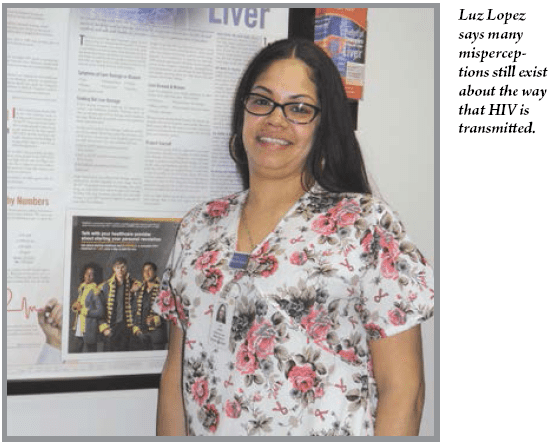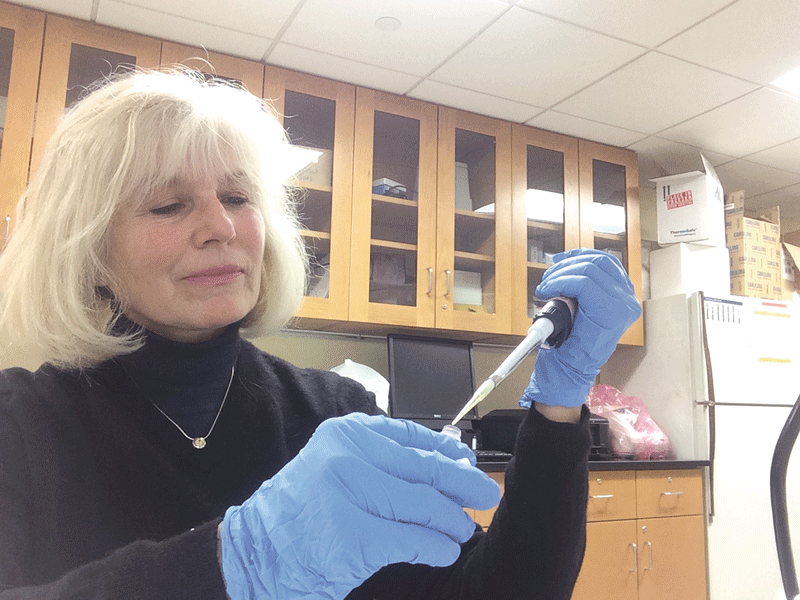Turning Point – New treatments for HIV/AIDS Change the Prognosis
Twelve years ago, when Martha Lang was diagnosed with end-stage AIDS, the 36-year-old understood the disease and knew it had reached epidemic proportions.
“I have a doctorate degree in medical sociology and had written my master’s thesis on AIDS,” said the college professor from Easthampton. But although the thesis made her aware of the importance of using condoms, she had unknowingly already contracted HIV, or human immunodeficiency virus, before she finished writing it.
Like many people, Lang had made the false assumption that the men she slept with did not have HIV. “As far as I knew, they had all tested negative,” she said.
Her illness began in 1999 with a bad case of shingles and weight loss. After a move to Indiana, she began getting sick more frequently, and in 2000 a cold led to extreme shortness of breath. She was told she had asthmatic bronchitis, but after repeated rounds of steroids and antibiotics and more weight loss, Lang ended up in the hospital in 2001, where she was diagnosed with pneumocystis carinii, or AIDS-related pneumonia.
Today, Lang is able to work 30 to 40 hours a week, has a spouse, and has been told that she can expect to live a normal lifespan. And since her diagnosis, Lang has made it her mission to speak about HIV and AIDS and tell her story as often as possible.
She has joined educators who encourage people to get tested, raise awareness, dispel myths, and let people know that treatment has changed dramatically and there is emotional and financial support available to and for people with HIV or AIDS.
Local experts agree that great progress has occurred since the ’90s. “When I see newly diagnosed patients, I tell them the bad news is that they have HIV, but the good news is that they have it in 2014,” said Dr. Daniel Skiest, chief of the Division of Infectious Diseases at Baystate Medical Center and a professor at Tufts University School of Medicine. “Treatment has changed dramatically and today there is an excellent chance that patients with HIV will only have to take one pill a day with minimal side effects.”
Skiest added that an unprecedented amount of research has changed the lifespan and quality of life for people living with HIV and AIDS today, and women with the virus can get pregnant without passing it on to their babies.

But there is still no cure, and the number of new cases in the U.S. has remained unchanged for 15 years. The Center for Disease Control estimates that 1,144,500 people 13 and older are living with HIV, and one in five with the infection are unaware that they have it and are unknowingly transmitting it to others.
Springfield has the second highest rate of infection in the state, behind Boston, and also has the second largest number of people living with HIV and AIDS, according to Jessica Crevier, executive director of the AIDS Foundation of Western Mass., who promotes education and does all she can to encourage people to get tested.
“People can feel perfectly healthy when they are infected, which is why testing is so important,” she said.
Skiest agreed. “There are still 50,000 new cases reported in the U.S. each year and everyone, regardless of risk factors, should get tested,” he told HCN.
Luz Lopez concurred. “An HIV test should be part of an annual check-up,” said the health educator from Brightwood Health Center in Springfield. “But many people tell me they know they don’t have the virus because they have been with the same partner for 10 years.”
In turn, she responds that she is happy they trust their partner, but has had married men tell her in confidence that they have had sex with other men. And Crevier has also met many people who have not told their partners or spouses they have HIV because they are afraid the person will leave the relationship.
Which means that looks can indeed be deceiving. “People can live without symptoms until the disease is quite advanced. They can be infected with HIV for many years before they develop AIDS and not find out they have it until they are very, very sick,” Skiest said. “We still see people who didn’t know they were infected and have very bad pneumonia or other infections that are manifestations of advanced HIV/AIDS.
“If they had been tested earlier, it could have been prevented, but it gets harder to treat as it becomes more advanced,” he continued. “It is better to be diagnosed when you’re asymptomatic, because people who catch it early and start treatment can expect a normal life span. And major studies show when people are on treatment that is working well, the chances of transmitting the virus to others is significantly reduced.”
Medical Advances
Reports from physicians in New York and California about outbreaks of two types of illnesses rarely seen in healthy young men first began to surface in 1981, and within months, similar cases were reported in 23 states and in the United Kingdom. But at that time, no one had a name for the condition or knew how to treat it.
“The HIV virus was not discovered until 1984,” said Skiest, noting that from 1981 to 1984 the infection was generally referred to as Gay Related Immune Deficiency, or GRID.

Even after the virus was identified, few treatments existed and the ones that were available were not very effective.
“The big breakthrough came in 1996, when researchers discovered the best way to treat the virus was with a combination of drugs called highly active anti-retroviral therapy, or HAART,” Skiest said. “When three drugs were used together, it led to a dramatic decrease in mortality and morbidity.”
But patients had to take four or five pills three times a day and usually suffered from crippling side effects.
The prognosis has changed, but since there is no cure, even if someone with AIDS has a complete recovery, he or she must continue to take medication for the rest of their life. “Although the virus may be undetectable in their bloodstream, it is still hiding within their body,” said Skiest, adding that research continues and Baystate Medical Center has conducted a number of clinical trials with qualified patients that have led to the approval of new medications.
Although all races and ethnic groups are susceptible to HIV, gay African American males have a disproportionate rate of infection. But in 2010, youths ages 13 to 24 accounted for an estimated 26{06cf2b9696b159f874511d23dbc893eb1ac83014175ed30550cfff22781411e5} of all new infections in the U.S., while women were diagnosed with 20{06cf2b9696b159f874511d23dbc893eb1ac83014175ed30550cfff22781411e5} of the estimated 47,500 new cases and 84{06cf2b9696b159f874511d23dbc893eb1ac83014175ed30550cfff22781411e5} of them were infected through heterosexual contact.
Doctors say infection in another group is also on the rise. “We’re seeing more HIV in patients over age 60,” Skiest said, adding although the virus can increase the risk of heart disease, cancer, and kidney disease, doctors often fail to offer the test to older patients because they don’t believe they are at risk.
Quelling Fear
Some people know they should get tested, but due to fear and stigma connected to the disease, they don’t want to go to their own doctor, said those we spoke with. But free confidential testing is available at Brightwood Health Center and Mason Square Neighborhood Health Center in Springfield from 8:30 a.m. to 4 p.m. and appointments are not required.
“All you have to do is show up and ask for a health educator,” said Lopez, adding that although positive test results must be reported to state Department of Public Health, the person’s identity is protected and the records are not put into the Baystate Medical Center system.
Lopez said the health centers can administer a rapid test that provides results in 10 to 20 minutes. If it is negative, there is no need for further testing, but if it is positive, a second, more conventional test is undertaken to confirm that the person is actually infected. It involves drawing blood, which is sent to a lab, and results usually come back within a week.
If the second test is positive, the person can be linked to services immediately at either clinic. Counseling is available in English and Spanish, and there is a multi-disciplinary team at each site. The teams include social workers, pharmacists, physicians, and registered nurses who work together and also help with insurance and medication costs.
“Most patients without private insurance are able to get all of their medication paid for through a state-funded program,” said Skiest.
But counseling is equally important.
“People fear the results, and if I tell them their test is positive, they are usually speechless,” said Lopez, adding that most people they test have HIV as opposed to AIDS. “But after I talk to them and explain that they can get all their care in one place, that HIV treatment has come a long way and they will be able to live a healthy, normal lifestyle, they begin to get more comfortable.
“It’s not a death sentence anymore — it’s a chronic disease that anyone can get, but it can take days, weeks or months to accept it,” she went on. “Some people want to begin care right away and others choose to wait, but we let them know that help is available, emotionally and financially; we work closely with patients for a long time.”
But acceptance and telling others about the diagnosis are two very different things, especially because of misperceptions that persist. Although HIV can only be transmitted through blood, semen, vaginal fluid, breast milk or by sharing needles with another person who is injecting drugs, many people think otherwise.
“A lot of people still believe they can get it by sharing a cup, spoon, dish or bathroom with someone who is infected,” said Lopez said. “But it doesn’t live in saliva or sweat, and when the virus is exposed to air, it dies within seconds.”
Crevier agreed. “I’ve met very educated people who still think you can get it from kissing, embracing, or sharing a drink with someone in the same way you can get a cold or the flu. Some also believe they can’t get HIV because they are heterosexual or don’t use intravenous drugs. So if people don’t understand how it is transmitted, they can’t protect themselves from it,” she said.
Lang feels compelled to talk about her experience because so many people don’t feel free to do so.
“I have a loving family and won’t lose them or lose my job or my housing, which happens to people all of the time as a result of their diagnosis,” she said, adding that she sought permission to talk to her classes at Brown University about her diagnosis. “The risk of rejection is very powerful, so I put a face on it for those who can’t speak for themselves.
“People want to pretend that HIV does not touch educated women, but it has nothing to do with who you are; it results from having unprotected sex or sharing needles with someone who has the virus,” she went on, adding that before she contracted the infection she thought her sexual partners were free of disease or infection. “You should never assume anything if you engage in behavior that could put you at risk.”
Crevier said the AIDS Foundation has a team of young people who visit students in middle school, high school, and colleges in Hampden and Hampshire counties to educate them about HIV/AIDS. “They’ve found that the students are not getting enough, if any, education on HIV and AIDS in their health classes,” she said.
Her agency’s mission is to increase awareness and spread the news that there is compassionate support available and services “to help people live in dignity, health and with a good quality of life.” It sponsors free, confidential peer support groups, provides financial support for people living with HIV/AIDS and also directs people to services that can offer help.
“People can apply to us for funding for housing, car repairs, furniture, fuel assistance as well as medical expenses,” said Crevier.
Critical Information
So although things have improved, the bottom line is that everyone should be tested for HIV, said those we spoke with.
“It’s important to do it for yourself and for your community,” said Crevier. “If you don’t know you have the virus, you’re depriving yourself of help to live a long and healthy life and also risk passing it to others, unknowingly and unintentionally, but effectively. Statistics don’t lie and it is still a problem.”
But it’s one that is entirely preventable — if people get tested every year, practice safe sex, and learn all they can so they can keep themselves and their loved ones happy, healthy and free from the dreaded diagnosis.




Comments are closed.